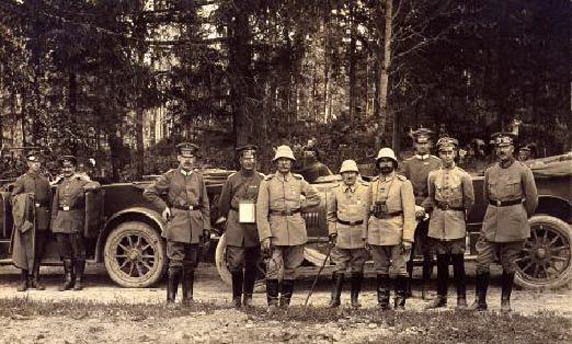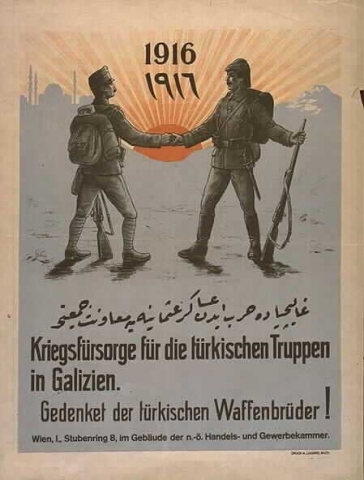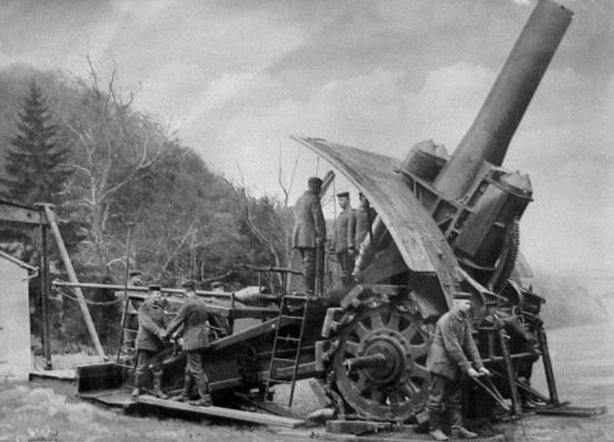On November 2, 1914, the Ottoman Empire entered the First World War on the side of Germany and Austria-Hungary. Before that, the state had already experienced three military campaigns (the Italo-Turkish War, 1911-1912, and the two Balkan Wars, 1912-1913), two of which ended for the Ottoman Empire with a heavy defeat and loss of large areas in Europe and North Africa.
During the period 1914-1915, Turkish troops had to fight on the five fronts at once: the Balkans, the Caucasus, Persia, Mesopotamia (Iraq) and Egypt. On the Caucasian front, they suffered the number of the painful defeats from the Russian army, but at the same time successfully repelled the attack of British and French troops in Gallipoli.
In 1916, the South-Western Front of World War I was on the territory of Ukraine: in Halychyna and Volyn. On April 1, 1916 in the General Headquarters of the Russian troops, the commanders of all fronts took the briefing, during which they fixed the term of the summer offensive. The commander of the South-Western Front, General Brusilov A. offered to attack at the direction of Lutsk with the forces of the 8th army. That sector became a major in the military campaign of 1916 in the East.
Before starting the offensive, Brusilov managed to have the two-three-fold superiority in manpower on the breakthrough territory; in addition, the powerful artillery attacks struck the whole front of Austro-Hungarian and German forces. During the offensive, most of the forces of the Central Powers, which located before the South-Western Front, were defeated. Only captives were for about 400 thousand people.
Under these conditions, Germany and Austria-Hungary asked the Ottoman government to send aid immediately. Turkish commanders decided to redeploy the 15th corps (The commander of which was Miralay Yakup Şevki Bey) from the area of Gallipoli to the Russian-Austrian front. The Corps included the 19th and 20th divisions.
Before the redeployment, the corps was reinforced with crew, weapons and uniforms that were taken from the other regiments of the Turkish army. The corps route ran across the territory of Bulgaria, Serbia and Hungary.
On August 5, the troops arrived to the front to the subordination of Lieutenant General von Bothmer. They received the front sector in the river Zolota Lypa, southwest from Berezhany. The immediate neighbors of Turkish soldiers were units of Ukrainian Sich Riflemen (USR). According to Gnatevych B. memories, "the Turkish army was very brave, and its officers, trained by Germans, were cultured Europeans."
Russians redeployed the 3rd Turkestan division against the 15th Corps on that front, hoping that the Turks would not fight against fellow Muslims, and begin to desert en masse. But it had quite the opposite effect — the inhabitants of Central Asia, dressed in Russian military uniform, joined the Turkish troops’ side with whole units.
During the first month of the battle, the 15th Corps lost 7,000 soldiers and 95 officers. In late October, at the Turkish soldiers sector, the battles became fierce, even the opponents met in hand-to-hand fight. Since November 1916, the intensity of the battles began to gradually decline in the South-Western Front. The Ottoman forces performed its task. In November, Cevat Pasha replaced Yakup Sevki Bey on the post of the commander.
In early 1917, the corps was reinforced with specially trained soldiers. According to American historian, Edward Erickson, the corps numbered 27031 people in January 1917. During that period, there were no active hostilities on the front, so the loss of Turkish troops was quite small. But, in June 1917, the Russian command began a new offensive. The artillery strike hit the 20th division of the 15th corps. The 43 thousand shells struck its position in a few hours.
July 1, the ottoman corps was subjected to a gas attack that became a serious challenge even for experienced soldiers. The High Command of the Russian army committed another reserves to the battle — forces from Siberia and Finland. But Turkish soldiers held positions, repulsed all the attacks. Loss of Russian troops on the area, defended with the 15th corps, reached into 13 thousand killed and wounded men.
After July 11, the coming rush of Russians became less intense. July 12, Turks counterattacked, closing the river Zbruch. By early August, the lull was all along the front-line.
The revolutionary storm of 1917 corruptively affected the Russian army. The anti-war mood was being intensified in troops; the number of deserters was growing continuously. In the fall, Russia's defeat was unavoidable.
Because of difficult situation of the Ottoman army on the Egyptian front, the command decided to redeploy the 15 Corps to the Middle East. In September 1917, the last units of the Turkish troops left Ukraine.
Killed on the battlefield of Halychyna, the Ottoman soldiers and officers were usually buried close to the front line. However, a lot of military personnel died in the hospitals of Budapest, Krakow, Vienna, Lviv. For example, there were 480 soldiers and officers of the 15th Corps, buried in the Turkish memorial cemetery of Budapest. Among the dead were not only Turks, but also Arabs and Kurds.
From August 1916 to August 1917, the 15th ottoman corps lost for about 25 thousand people in total, during the battles against Russian forces. On the territory of Ivano-Frankivsk Oblast’ there are at least six cemeteries of the Ottoman army soldiers. Among them, there is an officer cemetery in Gutysko village.
Until 1939, all places of graves of Turkish soldiers were being maintained in proper condition. But after the arrival of Soviet power, many cemeteries were destroyed or abandoned, and only after 2000s, some of them were restored thanks to the financial support of the Turkish government.
You can find the other materials about "History of Islam in Ukraine" by clicking the following reference.
Olexander Stepanchenko specially for "Islam in Ukraine"





